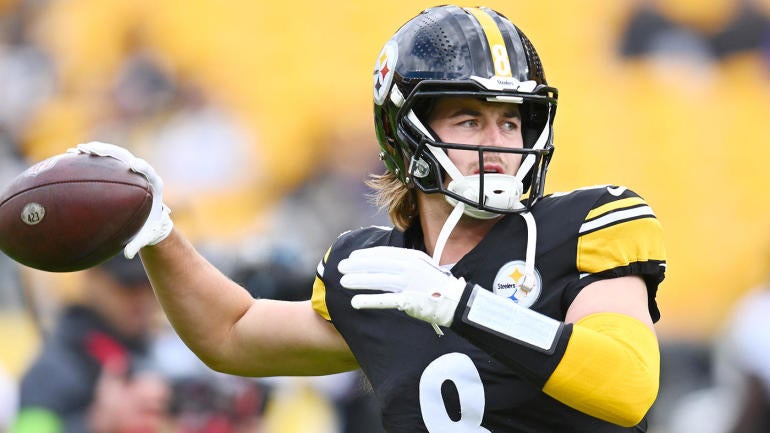
If you think you're seeing a little less action and scoring across the NFL this season, you're not alone, and you definitely don't need to get your eyes checked.
We are witnessing the worst offensive numbers to this point in the year in over a decade:
- Fewest points per game (21.7) through Week 7 since 2010
- Fewest touchdowns (491) through Week 7 since 2007
- Fewest yards per play (5.2) through Week 7 since 2006
- Lowest touchdown pass percentage through Week 7 since 1999 (3.8% of attempts)
- Fewest yards per completion (10.7) through Week 7 since at least 1940
Just about everyone is feeling it, unless you are the Dolphins, who scored 70 points against the Broncos in Week 3 and are seemingly breaking the scoreboard every week.
There's been room to capitalize on this offensive shortage. Sixty-two percent of games are hitting the "Under," the highest rate through Week 7 since 1986.
So where is all the offense hiding? Here's four reasons it's down across the league.
1. Changing of the QB guard
We're in the middle of a changing of the guard at the quarterback position. Peyton Manning, Tom Brady, Drew Brees, Ben Roethlisberger, Philip Rivers, Matt Ryan and Eli Manning have all left the league in the last seven years, and Aaron Rodgers tore his Achilles in Week 1. That's one reason quarterbacks are averaging 10.7 yards per completion this year, the lowest through Week 7 since at least 1940.
This was the youngest group of starting QBs to open a season since 1957. This is also the second-youngest average age of starting QBs (27) through Week 7 behind only 1987, which featured replacement players during the strike.
The youth movement has experienced its fair share of growing pains. Nine QBs made the first Week 1 start of their careers this season. Brock Purdy is the only one of those nine ranking in the top 10 in EPA per play among qualified quarterbacks, and even he's struggled lately. The other exception is C.J. Stroud, who set an NFL record for pass attempts before a player's first career interception (191).
| QBs Making First Career Week 1 Start This Season | 2023 EPA per Play Rank |
|---|---|
Brock Purdy | 2nd |
11th | |
C.J. Stroud | 14th |
Josh Dobbs | 20th |
21st | |
25th | |
27th | |
31st | |
Not qualified |
2. Offensive line play
Poor offensive line play is fueling some of the poor quarterback play. This is the highest sack rate (7.1%) we've seen through Week 7 since 2000 (7.2%).
CBS Sports NFL Analyst Brady Quinn described the issue on our Pick Six podcast last week.
"It's the lack of offensive lineman and the way offensive lineman are being coached, and I think that directly plays a result in all of this … because of so many things, the spread offense, junior high, high school level, 7-on-7 being more prominent than actual tackle football at a lot of youth levels. That's had an effect and impact trickling up, and I think offensive line play, because of the cut down of offseason programs and hitting, has also suffered due to that, which has obviously played a role in offensive production, running the football, the passing game."
The pressure rate (35.1%) and blitz rates (29.4%) this year are both the highest through Week 7 since Pro Football Focus began tracking this in 2017. It doesn't help that with more dual-threat, young QBs the average time to throw (2.79 seconds) is also the highest in the league through Week 7 in that time.
3. Defensive scheme
Give defense's credit too, explains Quinn.
"Schematically too, you're seeing less teams play just straight man, more matchup zones. Part of that is the game has gotten more spread out, and when the game gets more spread out and you've got more three wide receiver sets, in order to combat that, you don't want to put guys in position where they are more isolated, out in space in man-to-man coverage … so we're seeing a lot more softer coverage, drop eight, forcing QBs to have to be more patient, and actually read what the coverage is."
Quinn's right, teams are playing more two-high safety (44%) and zone coverage (70%) than any season since Pro Football Focus tracking began tracking that in 2017. This is the fifth straight season two-high safety rates have been on the rise.
Most of the league has struggled with fewer explosive plays and the death of the deep ball. There's been only 52 touchdown passes traveling at least 20 air yards this year, the fewest through Week 7 since this was first recorded in 2006.
Patrick Mahomes is one of the few QBs who has adapted. The reigning MVP and Super Bowl MVP has thrived in the last two seasons despite just two touchdown passes of 20-plus air yards.
Even run games haven't forced defenses out of soft coverage. This is the fewest explosive plays (10-yard runs and 20-yard passes) we've seen through Week 7 since 2009. The league is averaging 4.15 yards per rush this year, down from 4.51 last year, and the lowest through Week 7 since 2017.
4. Offensive execution
Wide-open offense hasn't led to great red zone execution. Red zone touchdown rates are down for a third straight season, and sitting at the lowest rate through Week 7 since 2017. The 2.7 yards per play in the red area is the lowest at this point in the year since 2011.
Offensive play is not as sharp early in the year with fewer preseason games, reduced hitting in training camp and less padded practices. The NFL is seeing its lowest yards after catch average (4.97) through Week 7 since 2010.
There's also less rhythm in the passing game, as Quinn describes. Shotgun rates (72%) are the highest on record, meaning fewer three-, five- and seven-stop drops translating to worse timing and anticipation on offense.
You'd think the silver living to less scoring would mean closer games, but that hasn't been the case either. The average margin of victory (11.8 points per game) is the third highest through Week 7 in the last decade.

















